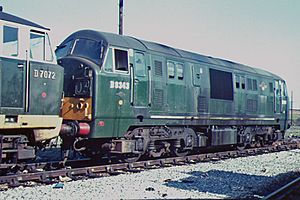British Rail Class 22 facts for kids
Quick facts for kids North British Type 2 diesel-hydraulicBritish Rail Class 22 |
|
 |
|
| D6343 with Hymek D7072 at Old Oak Common, 1965. | |
| Power type | Diesel-hydraulic |
|---|---|
| Builder | North British Locomotive Company |
| Build date | 1959–1962 |
| Total production | 58 |
| Configuration | B-B |
| UIC classification | B'B' |
| Gauge | 4 ft 8 1⁄2 in (1,435 mm) |
| Wheel diameter | 3 ft 7 in (1.092 m) |
| Wheelbase | 31 ft 6 in (9.60 m) |
| Length | 46 ft 8+1⁄2 in (14.237 m) |
| Width | 8 ft 8 in (2.64 m) |
| Height | 12 ft 10 in (3.91 m) |
| Locomotive weight | D6300–D6305: 68 long tons (69.1 t) D6306–D6357: 65 long tons (66.0 t) |
| Fuel capacity | 450 imp gal (2,000 L; 540 US gal) |
| Prime mover | MAN L12V18/21A or 21B |
| Transmission | Hydraulic: Voith LT306r |
| Multiple working | D6300–D6305: ■ Orange square D6306–D6357: ◆ White diamond |
| Top speed | 75 mph (121 km/h) |
| Power output | Engine: 1,000 hp (746 kW) or 1,100 hp (820 kW) |
| Tractive effort | Maximum: 40,000 lbf (177.9 kN) |
| Train heating | 1,000 pounds (450 kg) per hour steam generator |
| Train brakes | Vacuum |
| Career | British Railways |
| Number | D6300–D6357 |
| Nicknames | Baby Warship |
| Axle load class | GWR: ●Yellow BR: Route availability 4 |
| Retired | 1967–1972 |
| Disposition | All scrapped |
The British Rail Class 22 was a special type of train engine. It was known as a diesel-hydraulic locomotive. These engines were built for the Western Region of British Railways. They were made by the North British Locomotive Company between 1959 and 1962.
The Class 22 looked a lot like another train, the British Rail Class 21. People often called the Class 22 the "Baby Warship." This was because it looked similar to the bigger and more powerful British Rail Class D20/2 "Warship" locomotives.
Contents
What Was the Class 22?
The Class 22 was part of a big plan to modernize Britain's railways. This plan aimed to replace old steam trains with newer diesel and electric engines. These locomotives were designed to pull both passenger and freight trains. They were an important step in making train travel faster and more efficient.
How Did It Work?
The Class 22 was a diesel-hydraulic locomotive. This means it used a diesel engine to create power. But instead of turning the wheels directly, the power went through a special hydraulic system. This system used fluid pressure, much like the brakes in a car. It was different from diesel-electric trains, which use electricity to power their wheels.
Nickname: Baby Warship
The nickname "Baby Warship" came from its appearance. It shared a similar design style with the larger "Warship" class trains. These bigger trains were also diesel-hydraulic. The Class 22 was like a smaller version of them. This nickname helped people easily identify them.
Design and Features
A total of 58 Class 22 locomotives were built. They were given numbers from D6300 to D6357. These trains were known for their sturdy build. They had a B-B wheel arrangement. This means they had two bogies, each with two powered axles.
Engine Power
The Class 22 engines had a powerful MAN engine. This engine could produce either 1000 or 1100 horsepower. This power allowed them to pull heavy loads. They could reach a top speed of 75 miles per hour. This was quite fast for trains of their time.
Braking System
These locomotives used a "vacuum" braking system. This system creates a vacuum to apply the brakes. It was a common braking method on British trains back then. It helped ensure the trains could stop safely.
Where Did They Operate?
The Class 22 locomotives mainly worked in the Western Region of British Railways. This area covered parts of England and Wales. They were often seen on lines that were once part of the Great Western Railway. They pulled trains on both main lines and branch lines.
End of the Line
The Class 22 locomotives had a relatively short working life. They were introduced in 1959. However, they started to be retired from service quite early. Most were taken out of use between 1967 and 1972. All of the Class 22 locomotives were eventually scrapped. This means none of them survived to be preserved in museums.

